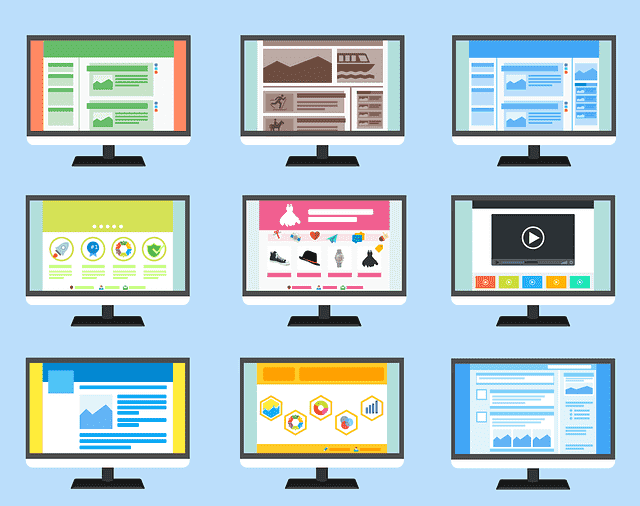The responsive web is a vital element of modern web development, which ensures that users can enjoy an uninterrupted browsing experience across all devices from smartphones to desktops.
In a time when increasing numbers of people use mobile devices to connect to websites, it’s essential that websites are optimized for different sizes of screens and types of devices.
In this blog, we’ll explore the fundamentals of responsive website design including its background, its workings and the reasons it’s crucial for modern companies and organizations.

Responsive design for the web is the process employed in web design that allows for the creation of websites that can be capable of adapting to various sizes of screens and different types of devices like laptops, desktops, tablets, smartphones, and more.
This ensures that users get the best experience when viewing on any device and without having to zoom or scroll in and out to view the content.
It utilizes CSS media queries as well as flexible grid systems and the ability to adjust the layout according to screen size and type to build a site that is adaptable and flexible to various gadgets.
What does responsive web design do?
Responsive Web Design is a method utilized to create websites that can be capable of adapting to various sizes of screens and different types of devices including laptops, desktops as well as smartphones, and tablets.
This design style ensures that users enjoy the best viewing experience on all devices with no need to zoom in or scroll into and out to look at the content.
What is a non-responsive website?
A non-responsive site is one that isn’t able to adjust its layout to various screen sizes.
When viewing on a smaller screen such as a smartphone users might need to be able to move the screen in order in order to see the content clearly or else the layout could appear to be distorted.
History of responsive web design:-
The idea that responsive websites first became popular at the beginning of 2010, since more and more users were using mobile devices to connect to the internet.
Ethan Marcotte is credited with inventing”responsive web design “responsive web design” in the article of 2010 and it has since grown into an industry standard for web design.
How does responsive web design work?
Responsive web design is achieved by making use of CSS media queries that allow the website to identify the size of the screen and the type of device and adjust the layout to match.
The site will usually employ an adjustable grid system that allows elements to be scaled and rearranged depending on the dimensions of the display.
Why is responsive web design important?
A responsive web layout is crucial since it offers a better experience for those who use the internet on various devices.
It also assists in ensuring that websites are easily accessible for as large a number of users as is possible, regardless of the device they use.
Furthermore, the responsive design could enhance the SEO of a website by making it mobile-friendly.
Responsive web design vs. adaptive web design:-
Responsive Web Design (RWD) and Adaptive Web Design (AWD) are two ways to create websites designed to be viewed on various screens and devices.
Responsive web Design is a method that makes use of flexible and fluid layouts, images as well as CSS media queries, to make an entire website that alters its appearance according to what size display it is displayed on. The layout alters dynamically when it’s size display alters, ensuring a great experience for the viewer.
Adaptive Web Design The alternative, however, uses pre-designed layouts that are optimized that are specific to screen sizes and orientations. This method uses JavaScript to determine the device’s screen size and then serves an already-designed layout specifically designed for the screen size. AWD creates a distinct version of the site for each screen size, delivering an experience that is customized for each device.
The two approaches RWD and AWD each have their pros as well as disadvantages. RWD is considered to be a more flexible method because it is based on one codebase which can adapt to any size screen.
It could be slower to load as the entire page must be drawn over for every screen size. AWD On the contrary is more efficient and provides an experience that is more customized for every device, however, it takes more effort to manage different versions of the site.
In the end, the decision of RWD as well as AWD will be based on the specific needs of the site as well as the intended audience.
If the website has to be compatible with a range of screen sizes and devices, RWD may be the most suitable choice. If the site has specifications for specific devices and screen dimensions, AWD may be a more suitable option.
What are the Pros of responsive design?
The primary benefits of responsive design are:
⇒ Improved User Experience: Responsive design gives you the most optimal viewing experience across all devices, regardless of the size of the screen or orientation.
⇒ Increased mobile traffic: With more and increasing numbers of people accessing the internet via smartphones, building a mobile-friendly website is becoming increasingly crucial.
⇒ Better Search Engine Optimization (SEO): Responsive design can improve a site’s ranking on search engines, as Google prefers mobile-friendly websites.
⇒ Reduced Development and Maintenance Costs: With a responsive design, it is no longer necessary to manage separate desktop and mobile versions of a site which can help save time and money.
⇒ Future-Proof: New devices that have various screen sizes are introduced the responsive design will ensure that websites will look and function correctly regardless of the device.
What are the Cons of responsive design?
The most significant disadvantages of responsive design are:
⇒ Slower loading times: Responsive design can cause slower loading times, particularly on slow internet connections because of the higher volume of code and data needed to display a single site across different devices.
⇒ Complex Design: The process of designing a responsive site is more complicated and time-consuming than creating an old-fashioned website because designers must take into consideration the different resolutions and sizes on which a website can be seen on.
⇒ Increased Testing Efforts: With responsive designs, websites must be tested across a range of devices to ensure it functions and looks well and efficiently. This can be time-consuming and expensive.
⇒ Limited Customization Responsive design could limit the degree of customization that is possible for various devices because designers are required to adhere to the limitations of one codebase.
⇒ Interaction Variations: The user experience may differ across devices since responsive design might not be able to allow certain interactions like gestures for touch, which are specific to particular devices.
Does responsive design help SEO?
Yes, responsive design can help SEO by making a website more mobile-friendly.
This can improve the website’s ranking in search engine results, as Google and other search engines favor mobile-friendly websites.
What will the future of responsive web design look like?
It’s difficult to know the future of responsive design on web pages however it is expected that the design will adapt to the ever-changing needs of both devices and users.
As new technologies are developed the responsive design can include new methods and approaches to offer the most optimal user experience.
Conclusion:-
A responsive design for web pages is an innovative method of web development, which provides the best viewing experience across all devices, including tablets, laptops, desktops, and mobiles.
The major benefits of responsive design are an improved user experience, increased mobile traffic, improved SEO for search engines, less cost of development and maintenance, and future-proofing.
But, a responsive design also presents its own set of challenges, such as slow loading times, a complex design, more testing with limited customization, and the differences in interactions between different devices.
Other Related Links:-









